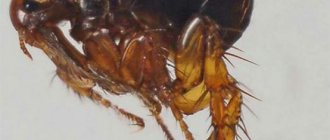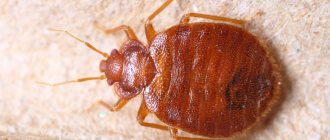The butterfly belongs to the order Diptera. In the external appearance of the insect there are similarities with moths, moths and flies. You can meet a butterfly not only at your summer cottage, but also in residential premises. About 200 species of butterflies live in Russia. The largest number of them is concentrated in the south of the country.
Description
Butterflies have a densely hairy body and wide, hairy wings, which makes them look like moths. Insects have poorly developed species differences. Adults can reach a length of up to 5 mm. The gray oval body sometimes has a blue tint. The color of an insect depends on the region where it lives.
The insect's wings are brown and covered with a speckled pattern. They have a leaf-shaped form. The butterfly's whiskers are long and striped. The legs of an insect consist of segments of different thicknesses. Their ends are directed from the head forward.
Ways to effectively control butterfly pests
The most important stage of growing vegetables is not at all preparing the soil or transplanting seedlings, but protecting the plants from a huge number of pests and diseases that strive to “eat” the crop before the owners of the garden. One of the most common vegetable garden pests is butterflies. These sometimes beautiful and harmless, at first glance, insects become a real disaster for careless gardeners who did not notice the threat in time.
Cute-looking butterflies can pretty much ruin your garden.
To prevent pest butterflies from multiplying in your area, destroying all the vegetables in a row, you should know which types you can encounter and how to deal with each of them.
It is impossible to examine in detail all the pests of this species in one article, so we will deal only with the most common butterflies in Russia.
Most often you can find three types of these insects:
Cabbage scoop. A large butterfly with two pairs of wings: one pair is white with blue spots, and the second is brown with black streaks. Harm to plants, like most butterflies, is caused mainly by caterpillars of this species; they devour leaves and flowers, preventing the fruits from developing
The cabbage cutworm is very prolific, so it is important to notice it in the garden in time and get rid of it before the butterfly lays eggs. Such pests can also settle in a greenhouse. Therefore, you should monitor cabbage and other crops in a greenhouse no less than those growing in open ground.
A motley butterfly that can severely damage cabbage
Therefore, you should monitor cabbage and other crops in a greenhouse no less than those growing in open ground. A motley butterfly that can severely damage cabbage
Winter armyworm. It is slightly smaller than cabbage, the wings have an earthy tint. The cutworm lays eggs in accumulations of weeds and grass, therefore, in order to prevent the appearance of such a pest, the beds are regularly loosened and rid of weeds.
Exclamation scoop. This is also a fairly large individual with a dark brown color. At the base of the wings there is a dark spot in the form of an exclamation mark, hence the name of the entire species. It’s not for nothing that such a scoop wears a warning sign. It is dangerous because it destroys very young plants when they are just beginning to sprout. To prevent the cutworm from eating all the sprouts, the soil is treated with a special anti-cutworm agent before planting.
There are several folk and commercial universal remedies that help rid vegetables of all types of cutworms. Plants attacked by cutworms can be treated with wormwood solution. The recipe for such a solution is quite simple: dilute a glass of ash, one and a half glasses of wormwood and a little soap in 10 liters of boiling water so that the solution stays longer on the leaves and stems of plants. The cutworm plant treated with this infusion will not eat it.
Good results are achieved by the usual measures to prevent the appearance of pests: regular weeding of the beds, deep digging of the soil in the fall, regular loosening.
Habitat, nutrition, reproduction
Insects love dampness.
In nature, they live in damp forests or swampy areas. In human homes, they find refuge near the sewer system, under basement canopies or in damp rooms without heating. Females lay eggs in manure or compost heaps, the remains of rotting vegetation. The larvae hatch from the eggs on day 7 and turn into tiny midges in 1-3 weeks.
Adults feed on nectar and pollen. The larvae eat rotting vegetation. Insects live in large colonies, so detecting their invasion is easy.
Lifestyle and reproduction
The odorous krasotel benefits people. An entomophagous predator helps control the number of dangerous tree pests:
- leaf roller;
- Volyanka;
- ringed and gypsy moths.
Beetles attack larvae and butterflies. The beauty runs and flies quickly. It hunts in the upper tier and descends to the ground to eat prey. Peak activity of adults occurs in the afternoon and evening. Larvae hunt at any time. Young beauties do not eat their prey entirely, but inflict fatal wounds on it. Adult beetles find caterpillars and moths by moving along tree trunks and branches. Having caught an insect, they try to find a convenient area for eating. The hunter does not always have enough strength to pull down a large hairy caterpillar; in this case, he feeds on a wide branch. Krasotel treats the victim's body with special softening enzymes. The beetle larvae have adapted to destroy the silkworm's web nests. Over the summer, they rid the forest of 60 caterpillars and 20 pupae. Adult beetles are more efficient; they have about 300 caterpillars.
Reproduction
Mating occurs in the spring. The female lays from 100 to 600 eggs in the soil. The ability to reproduce depends on the amount of food. Females need large amounts of protein. As the population of pest caterpillars increases, the number of beetles also increases. 1-2 weeks after laying, small larvae appear. They do not immediately leave the egg cradle, but wait for the appearance of a hard black cover. The offspring actively feeds and grows, molting and changing ages. In mid-July they burrow 25 cm into the soil and pupate. By August, young adults appear. The beetles do not leave the cocoons, remaining in them for the winter.
One generation of beauty beetles changes per year. The lifespan of insects is 2-4 years. Adult beetles hide in the forest floor for the winter. The following year they appear along with the young in May-June.
Harm
Insects do not pose a direct danger to humans. They do not bite, do not spoil plants and do not eat food supplies, but they are carriers of infectious diseases. Their annoying proximity causes discomfort. Butterflies contribute to the development of fungus and mold in the home, which worsens the sanitary condition of the premises and can cause various diseases in humans.
In rare cases of an insect bite on a person, serious consequences can arise for the latter. There is a high probability that pathogens of serious diseases will enter the bloodstream with insect saliva: fever virus and leishmania.
Rating of popular remedies
Among the popular means aimed at combating woodlice are:
- Tarax;
- Scabengel bait gel;
- Dichlorvos Varan;
- Get;
- Tetrix.
Tarax
Helps remove unwanted insects that have invaded your home. Effectively destroys:
Has good reviews from customers.
Scabengel bait gel
A German drug, one package of which is enough to treat a two-room apartment. Available in the form of a gel bait, it is placed in places where parasites accumulate. Keep the drug away from children and animals, as it is toxic.
New generation dichlorvos Varan
A universal remedy that allows you to effectively destroy small parasites in the house. Easy to use and cost a reasonable amount of money. Observe safety precautions when spraying.
Destroys the following insects:
It is sold in the form of a liquid concentrate and does not have a strong odor. The result appears within a week after application.
Tetrix
An expensive product that belongs to the professional category. Used by sanitary services during pest control operations. You can use it yourself at home, but before doing this you need to study the instructions for use in detail and strictly follow the manufacturer’s recommendations.
Fighting methods
The choice of method for exterminating the butterfly depends on the habitat of the insects and their number. You need to start fighting insects by eliminating their breeding places. When the butterfly infests the premises, the drainage systems are cleaned and disinfected. At the sites, cesspools, manure and compost heaps are treated with chemicals, and areas with high humidity are dried.
How to get rid of butterflies indoors using folk methods
Controlling insects in confined spaces requires a number of precautions. Sometimes, in order to get rid of unpleasant midges, it is enough to use mechanical methods - swatting them with a fly swatter.
This is the simplest, most accessible and inexpensive way to combat insects, requiring additional measures:
- treat the surfaces of midge locations with baking soda, laundry soap or a solution of table vinegar;
- eliminate the causes of high humidity in the room;
- block the paths for butterflies to enter the premises;
- Place pieces of citrus fruit zest in insect habitats.
Expert opinion
Mityuk Stefania Bogdanovna
The zest needs to be changed periodically. It must not be allowed to mold or dry out.
It is necessary to eliminate excess humidity in the premises and install additional heating.
Chemicals
Special preparations are used to combat large numbers of insects. It is best to use insecticides produced in the form of aerosols indoors. All these remedies should have an immediate effect. After treating the premises with them, they are closed for several hours, and then ventilated and wet cleaned.
"Dichlorvos"
The industry produces various types of aerosols: lavender-scented, odorless, universal, etc. All these products effectively cope with the task of destroying the butterfly. Universal dichlorvos helps exterminate not only adult insects, but also their larvae.
Before starting to treat premises with dichlorvos, remove dishes and food from them. When processing premises, you need to wear protective clothing, gloves, goggles and respirators. Aerosol cans are kept at a distance of 20 cm from the surface to be treated.
Advantages:
- efficiency;
- efficiency;
- versatility;
- availability;
- instant action.
Flaw:
- It is impossible to organize continuous spraying using a spray can.
The maximum effect from the use of aerosols can be achieved with focal treatment.
"Raid"
The action of the drug is aimed at damaging the nervous system of insects. After the aerosol hits the butterfly's body, it loses the ability to move and dies. The drug has a mild odor, but can irritate the human respiratory tract and cause toxic poisoning.
Therefore, treatment with “Raid” must be carried out with precautions similar to those with “Dichlorvos”. For room treatment, it is better to use “Raid” with flavorings. Such products have a less unpleasant odor and disappear from the premises faster.
Advantages:
- efficiency;
- ease of use;
- instant speed of action;
- moderate toxicity;
- versatility;
- availability.
Expert opinion
Mityuk Stefania Bogdanovna
The disadvantage is the frequent need for re-processing.
"Raptor"
The product has a universal effect and can be used to combat all types of insects. To achieve maximum treatment effect, it is necessary to use highly specialized aerosols.
The product is sprayed from a can at a distance of 25 cm from the surface to be treated. It is necessary to work with the drug only in special protective equipment. After spraying, the drug begins to act within 15 minutes.
Advantages:
- fast action;
- efficiency;
- availability;
- ease of use;
- availability;
- versatility.
The main disadvantage is that the product contains small dosages of insecticides, which may require re-treatment.
Causes of sewer flies
Butterflies breed in damp and warm places: in basements, attics, in bathrooms, showers, and toilets. If most insects suffer from increased dampness, then for flies it is vital.
Another condition for their existence is still, moist air. Often, butterflies appear in rooms where air exchange is disrupted: moisture vapor accumulates, and there is not enough fresh air. They can be found especially often in bathrooms, where they penetrate through openings in sewer pipes and along water risers.
Butterflies usually do not scatter throughout the premises, but settle near the site of infection. They are attracted to trash cans, clogged drains in sinks, and accumulation of moisture in various places. It is not uncommon to see flies in flower pots as they love moist soil. Sometimes they are mistaken for food or ordinary moths, the larvae of which gnaw cereals or spoil clothes. But this is not true, flies do not touch clothes and interior items.
Butterflies reproduce intensively in warm conditions, where food is available. Sensing the smell of food, insects crawl into the food. Therefore, where sewer flies appear, products should be kept closed.
Insects do not suck blood and do not attack people, but they pose another danger:
- From the sinks they move to the kitchen table and crawl on the food there. There are a lot of germs and dirt on their body and paws, which they contaminate food with.
- Butterflies live in colonies that nest on walls and ceilings. It is dangerous to bathe a child in a bathroom with too many sewer flies - insects can fly into his eyes or mouth.
- Spiders and other nasty insects feed on butterflies and their larvae. They also appear in an apartment where there are flies.
- Insect infestations cause an allergic reaction in some people.
Adviсe
Cleaning wastewater from butterfly infestations can be done using ammonium salts. The powder is poured into the pipes and 5 minutes after that, boiling water is poured. For a one-time treatment, it is enough to use 200 g of ammonium salt and 200 ml of boiling water.
What method of dealing with the butterfly would you choose?
FolkChemistry
In the open air, you can fight the butterfly with a solution of laundry soap. The working solution is prepared from 1 bar and 10 liters of water at room temperature.
Advantages and disadvantages of traditional methods
It is recommended to fight cabbage in your summer cottage using folk remedies using cabbage and other plants. To make effective preparations, plants, flower decoctions, spices, substances with a pungent odor, wood ash and much more are used.
The main advantage of the methods is safety for the environment and people. Especially when it comes to early varieties of cabbage. The decay period of the insecticidal substance is from 22 to 60 days. If poison enters the body along with a vegetable, it threatens the accumulation of toxins. It is impossible to feel the effect of the poison immediately, but with the same tactics of treating cabbage with poison, the risk of developing stomach ulcers and cancer increases several times.
The remedy for white cabbage is prepared from “available” ingredients that are always present in the household, medicine cabinet, and kitchen. The process is simple and does not take much time. There is no need to use personal protective equipment in the form of a respirator or suit. It is enough just to protect your hands with rubber gloves.
A significant drawback is that throughout the warm season you will have to repeat the cabbage treatment several times to achieve the desired result. To save cabbage from cabbage worms that have already appeared, spray the vegetable 2-3 times a week, depending on the product chosen. If you need to protect cabbage, once every 14 days is enough.











